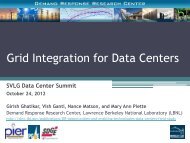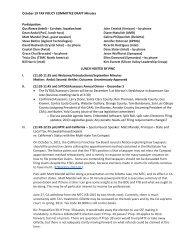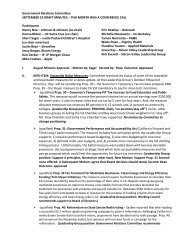2007 Silicon Valley Projections - Silicon Valley Leadership Group
2007 Silicon Valley Projections - Silicon Valley Leadership Group
2007 Silicon Valley Projections - Silicon Valley Leadership Group
You also want an ePaper? Increase the reach of your titles
YUMPU automatically turns print PDFs into web optimized ePapers that Google loves.
Housing<br />
The Biggest Barriers to Success…<br />
There are many barriers to building more homes but there are<br />
a few that are most significant, namely, how local governments<br />
are financed.<br />
In every decision that we as individuals make, cost is usually<br />
a factor. The same goes for cities. When considering a land use<br />
permit, an important question the city must ask itself is what<br />
kind of financial impact the future development’s needs will<br />
have upon the city. Demands on city services, schools and<br />
infrastructure, all of which must be maintained at some cost,<br />
are associated with housing construction and to a lesser extent,<br />
office parks or big box retail. As a result, fiscal considerations<br />
have become a major barrier to building homes. These considerations<br />
were made more acute five years ago when the State<br />
government decided to balance its budget, in part, by taking<br />
local government money.<br />
Percent of Regional Housing Needs Allocation<br />
(RHNA) Permitted<br />
County Very Low Low Moderately Total<br />
Income Income Low Income<br />
Alameda . . . . . . . . . .24% . . . . . . .38%. . . . . . . . . 20% . . . . . . .65%<br />
San Mateo . . . . . . . . .19% . . . . . . .45%. . . . . . . . . 16% . . . . . . .58%<br />
Santa Clara . . . . . . . .55% . . . . . . .98%. . . . . . . . . 17% . . . . . . .75%<br />
Regional Total . . . . . .34% . . . . . . .70%. . . . . . . . . 29% . . . . . . .80%<br />
(9-County region)<br />
Source: Association of Bay Area Governments<br />
Proposition 1A was passed in 2004 to protect local governments<br />
against future State “raids” and to provide local governments<br />
with much-needed financial certainty from year to year.<br />
Housing advocates also hoped this certainty would lead to more<br />
favorable outcomes when considering housing permits.<br />
However, the allegation that housing doesn’t pay for itself still<br />
persists. Residents wary of a decline in city services and quality<br />
of life continue to express concern over new home construction,<br />
especially if those homes don't mirror the ones they live in.<br />
This is a problem that is difficult to solve. Cities are<br />
entrenched in the way local governments are financed and any<br />
talk of change makes them very uncomfortable. For example,<br />
cities such as Gilroy have worked hard to grow their revenue<br />
base through outlet stores. Any changes to how local governments<br />
are financed would need to respect those decisions.<br />
It is unrealistic to expect substantial change to how local<br />
governments are financed. However, there are ways that we<br />
can provide a work-around solution. Very simply, cities and<br />
counties should be rewarded for good land use planning and<br />
the resulting housing production.<br />
Programs such as the Metropolitan Transportation<br />
Commission’s Transportation for Livable Communities are an<br />
excellent example of a way to reward cities. The program<br />
awards grant funds to cities that meet certain housing production<br />
requirements at specific densities near transit. So far,<br />
23 housing developments have been awarded $7 million to<br />
create nearly 2,700 new housing opportunities throughout the<br />
Bay Area. MTC expects to provide up to $30 million to qualifying<br />
projects in the upcoming round of grants. This success<br />
should be expanded locally, regionally and statewide.<br />
Another huge challenge in meeting the need for more homes<br />
is community opposition. Rarely does a community open up<br />
its arms to welcome a developer. Instead, developers are seen<br />
as people who wish to bring unwanted change to a neighborhood,<br />
change residents fear will decrease the quality of<br />
schools, increase traffic congestion, and add demands for existing<br />
city services such as parks and libraries.<br />
The end result of systematic community opposition can be<br />
found in reduced densities, heights and the overall number of<br />
homes being built. Council by council, project by project, our<br />
ability to meet the demand for homes with the limited land<br />
available is whittled away through a reduction in the number<br />
of homes ultimately approved for construction.<br />
A good illustration of this is the Hyatt Rickeys site in Palo<br />
Alto. The applicant originally sought 304 homes. The<br />
surrounding community did not like the proposal for a number<br />
of reasons and at the end of the day, a significantly scaled<br />
back version was approved by the council for 181 homes. In<br />
essence, the opportunity to house 123 additional families on<br />
that site was lost.<br />
This story is played out all across the State every week as cities<br />
approve developments that squander housing opportunities.<br />
Couple this with recent research out of UC Berkeley on infill<br />
capacity statewide and the problem is magnified. The study<br />
projects that 25% of the need for more homes can be accommodated<br />
through infill, meaning 75% will be sprawl, leading<br />
to the consumption of valuable open space, farmland and<br />
requiring heavy taxpayer investments in new infrastructure to<br />
serve sprawling communities.<br />
To make matters worse, there has been an increase locally of<br />
citizen backed measures to control or stop growth. Last year,<br />
three initiatives in Cupertino that would have made it infeasible<br />
to build condominiums and publicly funded affordable<br />
homes qualified for the ballot. All three were defeated but the<br />
this year some Cupertino residents qualified two more initiatives<br />
to rescind the approval of two condominium proposals<br />
near Vallco shopping center. In 2003, Palo Alto citizens tried<br />
45












